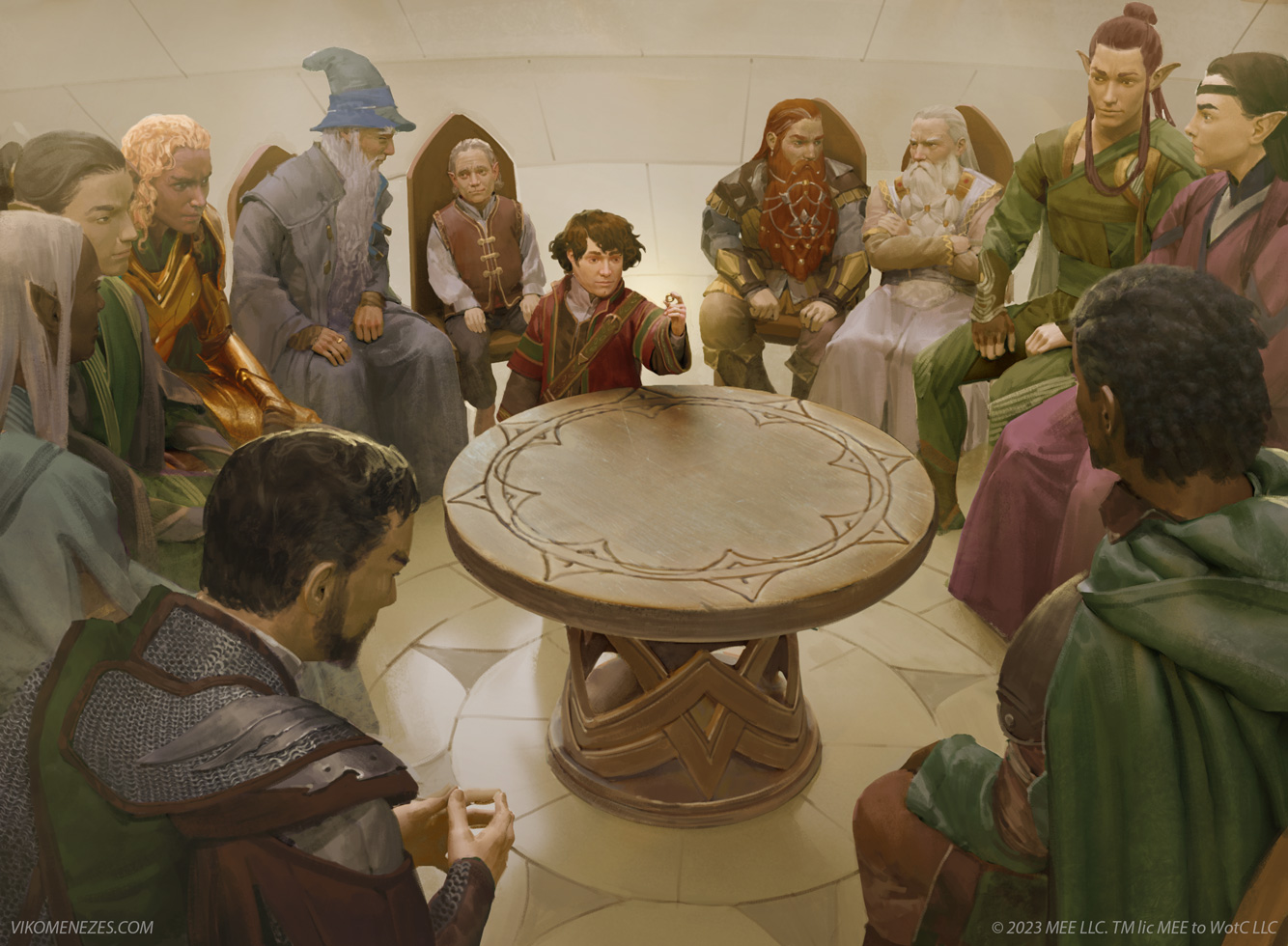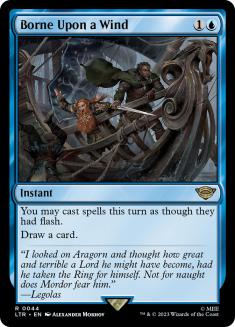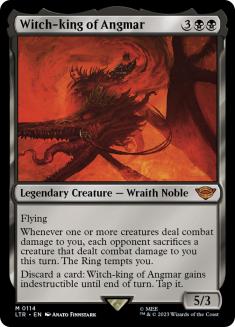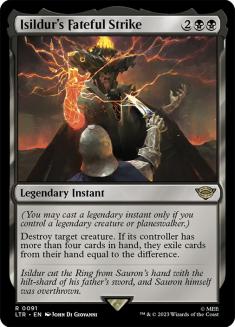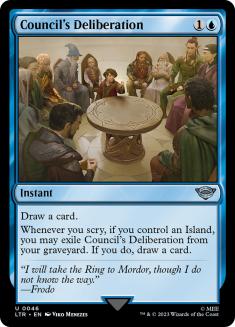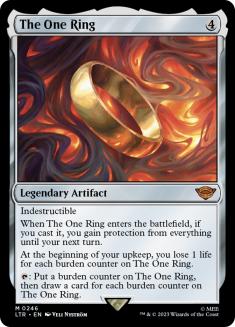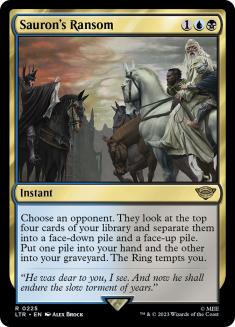The Lord of the Rings: Tales of Middle-earth is the talk of the Magic community. From the bounty of the 1/1 serialized The One Ring to the dynamite flavor of the cards, this set is creating quite the buzz.
I describe myself as a moderate fan of The Lord of the Rings, but even I have geeked out from some of the card designs. They feel authentic and compatible with traditional Magic gameplay, with even some competitive possibilities.
I am a bona fide Spike. The analysis I provide from upcoming sets is through that lens, so my mind goes straight to tournament viability. Often that boils down to control deck enhancement, but I can respect upgrades that go to other archetypes. I have even dabbled in Commander, which is where the biggest impact will be from this set. With card design, Wizards of the Coast (WotC) has shifted its language to “each opponent” or “whenever a player” to provide additional upside in multiplayer settings. This is a smart move and requires all Commander enthusiasts to fill up their shopping cards with these must-plays.
When looking through a set like this for tournament staples, pickings can be slim. The Lord of the Rings: Tales of Middle-earth will go straight to Modern legality, where Azorius Control (Kaheera) is the top control dog. This does not mean other color combinations aren’t viable; however, it is tough to get me off this archetype with the tools currently at our disposal. In this set, I only found one card that could potentially be an upgrade to Azorius Control (Kaheera), but there are a few possibilities for black-based control. Out of nowhere, Esper Control became viable a couple of years ago. A few cards here and there could lead to lightning striking twice.
Honorable Mention: Borne Upon a Wind
Whenever I see a cheap blue cantrip, I immediately begin to analyze its impact in relevant formats. Quicken has had a special spot in my heart ever since I scrubbed out of an early Pro Tour while attempting to cast Wrath of God at instant speed. Even though that experience was poor, I still like the low opportunity cost that a card like Quicken has built in. Borne Upon a Wind is the next rendition of that but allows for any spell to be cast as an instant.
Borne Upon a Wind allows you to cast spells as though they had flash, where Quicken was restricted to the next sorcery. As a card-carrying member of the Teferi, Time Raveler fan club, I can vouch for the addictiveness of having that ability at the ready. Unfortunately, it costs two mana and the spells that you want to cast in the opponent’s turn are sorceries, very rarely planeswalkers, enchantments, or artifacts. Borne Upon a Wind is a cool card with some nostalgia feels, but it will not see competitive play.
#5: Witch-king of Angmar
Starting our list off is the Witch-king of Angmar, a win condition that I would not write off in a Modern control deck. It is immune to traditional remove and combat damage by simply discarding a card, giving the user tap-out confidence. Even if the opponent uses a removal spell to prevent it from blocking for the turn, it seeks vengeance by triggering a sacrifice. Whenever one or more creatures deal combat damage, their controller is forced to sacrifice one of them. In Modern, this becomes a difficult-to-answer source of removal that also closes out the game.
Witch-king of Angmar is a five-power creature with evasion. This creates a quick clock for the opponent, while protecting the user from opposing creatures in the process. Waiting for opponents to attack with creatures, using removal from hand, and then having Witch-king of Angmar clean up the remaining threat is a play pattern I can get behind. In addition, it has that “The Ring tempts you” clause, giving even more upside to an already strong win condition.
There are a few drawbacks of Witch-king of Angmar. It being outside the Azorius family makes it a future possibility in potential, black-based control decks. Another thing going against it is the prevalence of exile effects in Modern, making it vulnerable against certain archetypes. The five-cost investment makes it a liability against those cheap exile effects, not to mention blue disruption, still lurking around the top of the Modern food chain.
#4: Isildur’s Fateful Strike
I always welcome more removal options to the card pool, especially those with unique effects. Isildur’s Fateful Strike is an instant-speed removal spell that takes out any creature for four mana. That price tag is fairly high; however, the effect is strong against certain matchups. This is not a removal spell you want against aggro decks. It costs a bunch, and the opponent will not have a grip of cards when it resolves. Isildur’s Fateful Strike punishes opponents in the slower matchups, taking out their creature and forcing the owner to exile down to four cards.
There are plenty of matchups in Modern that have a draw-go feel where this removal spell could shine. It is a way to gain lost ground in the card advantage war or punish an opponent who just cashed in on a chunky card draw spell. I do not see this immediately finding a home, but I think it has sideboard potential in competitive play.
#3: Council’s Deliberation
I never thought I would celebrate the return of Think Twice to Modern control. There was a time when Think Twice was the staple draw spell for all flavors of the control color wheel. Until very recently, Guillaume Wafo-Tapa was still rocking them in his Esper Control list, and the reasoning behind it makes sense. Many of us are playing Dress Down, Shark Typhoon, and/or Spreading Seas to get that Think Twice feel in the early-game. It provides an additional opportunity to hit the third and fourth land drops, while offering upside as the game progresses. With Council’s Deliberation, it does the same thing, with zero additional resources required.
Council’s Deliberation is the perfect control card if there are opportunities for scry in the deck. For two mana, you get to draw a card, following the same baseline as the other cards in that slot. The moment you scry, if you control an Island, Council’s Deliberation exiles from the graveyard and rewards the user with an additional card. That is two cards for the price of one, with the requisite of having cards with scry in the deck.
In my current Azorius Control (Kaheera) build, I have no scry ability outside of Castle Vantress. If there was a four-of that had scry, in addition to that land, I would consider slotting Council’s Deliberation right in. It is no secret that I begrudgingly play Dress Down to have that potential upside against an opposing creature while on my way to land drop heaven. It rarely works that way, so I am looking for any excuse to get another cantrip in there. For those with some scry going on in their deck, I encourage trying out Council’s Deliberation.
#2: The One Ring
What would a The Lord of the Rings Top 5 list be without The One Ring being there? This is the source of the fervor, and I am here for it. I have been a Phyrexian Arena fan for a long time, and The One Ring blows that out of the water. It only costs one more and provides a pile of extra benefits. The turn it arrives, it provides the user protection from everything for a full turn. In addition, it is indestructible, making it very difficult for an opponent to remove it.
The turn you cast The One Ring, you can immediately draw a card. The next turn, that lever can be cranked to two cards, with the life loss increasing with it. Many Modern decks do not punish players for playing fast and loose with life totals, opening a competitive window for a card like The One Ring. It can absolutely get out of hand, with the impressive card draw, protection from everything when resolved, and the resiliency of the artifact itself.
I am not sure which home The One Ring will find itself in. Even for cards this strong, it takes something very special to breach into Modern viability. I will likely toy around with a copy or two in traditional control decks. I may even throw together an Urza, Lord High Artificer deck to give The One Ring the good old college try. Even if it does not see immediate use in Modern, it has caught the attention of Magic players all across the competitive spectrum.
#1: Sauron’s Ransom
In the spirit of nostalgia, a card like Fact or Fiction has arrived in this new set. Fact or Fiction is Modern-legal but sees no play due to its mana cost. It is simply worse than Memory Deluge, which has become the staple card draw spell for all control decks. Sauron’s Ransom does not provide the two face-up piles that I enjoyed with Fact or Fiction; however, it costs a full mana less.
Dropping one mana could take a completely unplayable card and immediately make it best-in-class. That is a possibility with Sauron’s Ransom, since it costs only three mana. This spell prompts the opponent to create two piles, one face-up and one face-down, for the user to select. The selected pile goes to the hand, where the other goes to the graveyard. Like with Fact or Fiction, filling the graveyard could have relevant implications. A card like Memory Deluge is more efficient with a late-game bang but does not service the graveyard in any way.
This is my favorite control card from the set and I will likely test it when I return to black-based control. In addition to the card draw, the user is tempted by The Ring, an ability that may find relevance in Modern. We all thought the initiative was a joke, until it obliterated Legacy. I do not think that this set-specific ability will mirror that strength, but we can never completely write it off. I am happy that it is attached to an already efficient card draw spell, just in case Esper Control is primed for a triumphant return.

